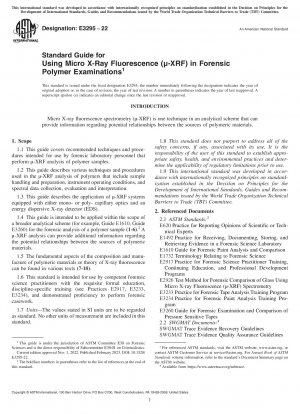ASTM E3295-22
Standard Guide for Using Micro X-Ray Fluorescence (μ-XRF) in Forensic Polymer Examinations
- Standard No.
- ASTM E3295-22
- Release Date
- 2022
- Published By
- American Society for Testing and Materials (ASTM)
- Status
- Replace By
- ASTM E3295-23
- Latest
- ASTM E3295-23
- Scope
- 1.1 This guide covers recommended techniques and procedures intended for use by forensic laboratory personnel that perform µ-XRF analysis of polymer samples. 1.2 This guide describes various techniques and procedures used in the µ-XRF analysis of polymers that include sample handling and preparation, instrument operating conditions, and spectral data collection, evaluation and interpretation. 1.3 This guide describes the application of µ-XRF systems equipped with either monoor polycapillary optics and an energy dispersive X-ray detector (EDS). 1.4 This guide is intended to be applied within the scope of a broader analytical scheme (for example, Guide E1610, Guide E3260) for the forensic analysis of a polymer sample (1-6).2 A µ-XRF analysis can provide additional information regarding the potential relationships between the sources of polymeric materials. 1.5 The fundamental aspects of the composition and manufacture of polymeric materials or theory of X-ray fluorescence can be found in various texts (7-18). 1.6 This standard is intended for use by competent forensic science practitioners with the requisite formal education, discipline-specific training (see Practices E2917, E3233, E3234), and demonstrated proficiency to perform forensic casework. 1.7 Units—The values stated in SI units are to be regarded as standard. No other units of measurement are included in this standard. 1.8 This standard does not purport to address all of the safety concerns, if any, associated with its use. It is the responsibility of the user of this standard to establish appropriate safety, health, and environmental practices and determine the applicability of regulatory limitations prior to use. 1.9 This international standard was developed in accordance with internationally recognized principles on standardization established in the Decision on Principles for the Development of International Standards, Guides and Recommendations issued by the World Trade Organization Technical Barriers to Trade (TBT) Committee.
ASTM E3295-22 Referenced Document
- ASTM E1492 Standard Practice for Receiving, Documenting, Storing, and Retrieving Evidence in a Forensic Science Laboratory
- ASTM E1610 Standard Guide for Forensic Paint Analysis and Comparison
- ASTM E1732 Standard Terminology Relating to Forensic Science
- ASTM E2917 Standard Practice for Forensic Science Practitioner Training, Continuing Education, and Professional Development Programs*, 2024-02-01 Update
- ASTM E2926 Standard Test Method for Forensic Comparison of Glass Using Micro X-ray Fluorescence (µ-XRF) Spectrometry
- ASTM E3233 Standard Practice for Forensic Tape Analysis Training Program
- ASTM E3234 Standard Practice for Forensic Paint Analysis Training Program
- ASTM E3260 Standard Guide for Forensic Examination and Comparison of Pressure Sensitive Tapes
- ASTM E620 Standard Practice for Reporting Opinions of Technical Experts
- ISO/IEC 17025 General requirements for the competence of testing and calibration laboratories [Standard in French]
ASTM E3295-22 history
- 2023 ASTM E3295-23 Standard Guide for Using Micro X-Ray Fluorescence (μ-XRF) in Forensic Polymer Examinations
- 2022 ASTM E3295-22 Standard Guide for Using Micro X-Ray Fluorescence (μ-XRF) in Forensic Polymer Examinations
